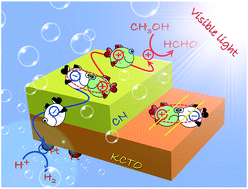Dion–Jacobson-type perovskite KCa2Ta3O10 nanosheets hybridized with g-C3N4 nanosheets for photocatalytic H2 production†
Abstract
Dion–Jacobson-type perovskite oxide KCa2Ta3O10 has been identified as a promising semiconductor for photocatalytic H2 evolution. However, its ultraviolet-light-driven nature restricts its practical application. To solve this problem, for the first time, g-C3N4/KCa2Ta3O10 (CN/KCTO) 2D–2D nanosheet heterojunctions with strong interfacial interaction were developed by a facile two-step wet chemistry strategy. The H2 evolution rate of CN/KCTO was more than twice that of bare CN. The good photocatalytic H2 evolution activity of CN/KCTO under visible light irradiation indicated that the formation of 2D–2D heterojunction structure not only can enhance the solar spectrum utilization of KCTO, but also can effectively accelerate the photo-induced charge separation and elevate the charge transfer efficiency of CN. This work implies that the construction of 2D–2D heterojunctions with strong interfacial interaction based on Dion–Jacobson-type perovskite oxide and a narrow band gap semiconductor material is an effective way to obtain high-performance visible-light-driven photocatalysts for solar fuel production.



 Please wait while we load your content...
Please wait while we load your content...